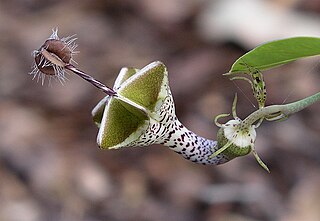
The Asclepiadoideae are a subfamily of plants in the family Apocynaceae. Formerly, they were treated as a separate family under the name Asclepiadaceae, e.g. by APG II, and known as the milkweed family.

Ceropegia is a genus of plants within the family Apocynaceae, native to Africa, southern Asia, and Australia. It was named by Carl Linnaeus, who first described this genus in his Genera plantarum, which appeared in 1737. Linnaeus referred to the description and picture of a plant in the Horti Malabarici as the plant for which the genus was created. In 1753 he named this species as Ceropegia candelabrum. Linnaeus did not explain the etymology but later explanations stated that the name Ceropegia was from the Greek word keropegion κηροπηγɩον. This means candelabrum in Latin, which has a broader range than the modern word - "a candlestick, a branched candlestick, a chandelier, candelabrum, or also lamp-stand, light-stand, sometimes of exquisite workmanship".

Stapeliinae is a subtribe of flowering plants within the tribe Ceropegieae of the subfamily Asclepiadoideae of the family Apocynaceae. The subtribe comprises about 35 genera, including both the stem-succulent "stapeliads" and the horticulturally popular genera Brachystelma and Ceropegia. The largest number of genera are native to Africa, but a more limited number of genera are widespread in Arabia and Asia. Historically, a similarly circumscribed taxon was treated as a separate tribe, Stapelieae.

Stapelia is a genus of low-growing, spineless, stem succulent plants, predominantly from South Africa with a few from other parts of Africa. Several Asian and Latin American species were formerly included but they have all now been transferred to other genera. The flowers of certain species, most notably Stapelia gigantea, can reach 41 cm (16 inches) in diameter when fully open. Most Stapelia flowers are visibly hairy and generate the odor of rotten flesh when they bloom.

The genus Huernia consists of perennial, stem succulents from Eastern and Southern Africa and Arabia, first described as a genus in 1810.

Cynanchum is a genus of about 300 species including some swallowworts, belonging to the family Apocynaceae. The taxon name comes from Greek kynos and anchein, hence the common name for several species is dog-strangling vine. Most species are non-succulent climbers or twiners. There is some evidence of toxicity.

Ceropegia stapeliiformis is a flowering plant in the genus Ceropegia (Apocynaceae), native to South Africa and Eswatini. Common names include serpent ceropegia, snake creeper, and slangkambro.

Duvalia is a succulent plant genus in the subfamily Asclepiadoideae, in the family Apocynaceae (dogbane).
Dischidia is a genus of plants in the “dog-bane” family Apocynaceae, collectively known as the “milkweeds”. They are epiphytes, native to tropical areas of China, India as well as Bhutan’s southern borders, wherever minimal frost occurs. Additionally, they are known from most areas of Mainland Southeast Asia, including forested areas of Myanmar, Thailand, Vietnam, Cambodia, Laos, and some parts of Indonesia, Malaysia and Singapore. Several species are also native to Papua New Guinea and northeastern Australia.

AnacampserosL. is a genus comprising about a hundred species of small perennial succulent plants native to Southern Africa, Ethiopia and Latin America. The botanical name Anacampseros is an ancient one for herbs supposed to restore lost love.

Fockea is a genus of succulent scrubs native to Africa south of the equator. They are members of the Asclepiadoideae (milkweeds), a subfamily of the dogbane family Apocynaceae. Of the six recognized species, only the two most widely distributed extend north of southern Africa, with F. multiflora reaching as far north as Tanzania and F. angustifolia reaching to southern Kenya. Fockea are known as water roots, a reference to the bulbous caudex characteristic of most species, which is also edible in at least some species.
Ceropegia striata is a plant species endemic to Madagascar. It is known only from the Vavavato Massif in the central highlands, at an elevation of approximately 1800 m.

Philibertia is a genus of flowering plants in the family Apocynaceae, first described as a genus in 1819. It is native to South America.

Pachycarpus is a genus of plants in the family Apocynaceae, first described in 1838. It is native to Africa.

Raphionacme is a plant genus in the family Apocynaceae, first described as a genus in 1842. The genus is found primarily in Africa, with one species on the Arabian Peninsula.

Ceropegia candelabrum is the type species in its genus of plants, belonging the subfamily Asclepiadoideae. The Latin specific epithet candelabrum is derived from the candelabra-like appearance of the inflorescences.
















